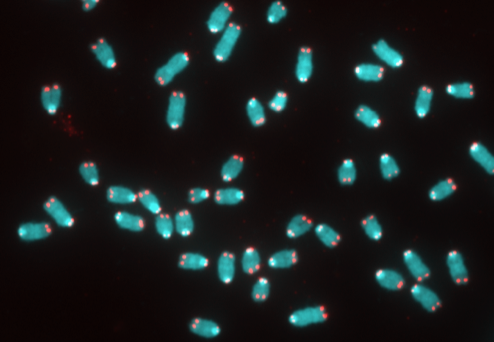Researchers at the University of Maryland (UMD) and the National Institutes of Health (NIH) have identified a previously unknown role for the enzyme telomerase. Until now, the only known role for telomerase in normal tissues has been to protect certain cell types, such as embryonic cells, sperm cells, adult stem cells, and immune cells, from aging. Telomerase is also known to enable cancer cells to undergo unlimited cell division. But scientists had thought that, apart from these two functions, the enzyme was turned off in all other cells.
Results from the new study, reported in the Proceedings of the National Academy of Sciences (PNAS) have shown that telomerase is reactivated in normal adult cells at the latter stage of cell aging, and this activity reduces the potential for DNA damage that could lead cells to become cancerous. “This study reshapes the current understanding of telomerase’s function in normal cells,” said Kan Cao, PhD, an associate professor of cell biology and molecular genetics at UMD, who is senior author of the study. “Our work shows, for the first time, that there is a role for telomerase in adult cells beyond promoting tumor formation. We can now say that regulated activation of telomerase at a critical point in a cell’s life cycle serves an important function.” Cao and colleagues describe their findings in a paper titled, “Transient induction of telomerase expression mediates senescence and reduces tumorigenesis in primary fibroblasts.”
Telomeres are DNA-protein structures sited at the ends of chromosomes. In normal somatic body cells telomeres shorten at each cell division until they reach a critical length. At this point, the cell generally stops dividing and dies, but it may also acquire DNA damage and become cancerous. In some cell types, telomerase acts to protect the telomeres and prevent them from shortening as the cell continues to divide. The enzyme plays a critical role during embryonic development and stem cell differentiation, when cells divide abundantly. “Telomerase activity is required for the maintenance of stemness in stem cells, and its expression is precisely regulated in stem and progenitor cells …” the authors wrote. “Somatic cells without telomerase activity exhibit a limited replicative capacity and after a finite number of cell divisions reach a state known as replicative senescence that can be abrogated by ectopic telomerase expression.”
Telomerase comprises two essential subunits, the template RNA (TR; telomerase RNA), and the reverse-transcriptase catalytic subunit (TERT; telomerase reverse transcriptase). Studies have shown that when mice are continually bred to lack telomerase, the later generations tended to have relatively shorter lifespans, shorter telomere length (TL), and an increased likelihood of developing cancers. These animals were the offspring of normal (wild-type) mice and genetically modified mice that had been bred for many generations without the ability to produce telomerase. While all the offspring had abnormally short telomeres, the mice that had not inherited the gene to produce telomerase from their wild-type parent lived relatively short lives, exhibited progressive tissue atrophy and were more likely to develop spontaneous cancers.
Research has also suggested that it is the lack of TERT expression in particular that plays a critical role in the deficits exhibited by telomerase-deficient mice, as the effects of telomerase deficiency could be reversed by reactivating TERT in these animals. This led the team to consider whether telomerase may play a role in somatic cell senescence and aging. “Based on this observation, we speculate that telomerase activity in senescent somatic cells with short telomeres might have additional roles beyond promoting tumor formation,” the team noted.
To look at this more closely Cao and her colleagues first compared the skin cells of the sibling mice. They found that while cell lines from the telomerase-producing and telomerase-deficient mice had comparably short telomeres, cells from animals that lacked telomerase stopped dividing sooner and developed more malignant transformations than cells from siblings that produced telomerase. When skin cells from mice that could make telomerase approached critical telomere length, they naturally produced a burst of the enzyme, which slowed the process of telomere shortening and reduced the amount of DNA damage that might lead to cancer. The researchers believe that these results suggest that telomerase expressed near the end of a cell’s lifespan effectively softened the aging process and led to a more gradual cell death.
Further experiments also showed that reactivating telomerase gene expression in the telomerase-deficient cells was enough to rescue the cells, extending their ability to divide and reducing DNA damage.
Interestingly, a separate series of studies showed that normal human skin cells also expressed telomerase as they approached critical shortened telomere length. When the researchers then used either CRISPR-Cas9 gene editing or shRNA technology to disable telomerase expression, the cells showed reduced expression of genes that are involved in DNA damage response (DDR) at the key presenescence stage.
“Here, we report that telomerase is transiently up-regulated at the presenescence stage in both murine and human cells, and the cells that are unable to induce telomerase expression approach senescence earlier and exhibit a significantly higher rate of transformation,” the authors reported. “Together, these results support that the transient induction of telomerase at presenescence is of importance in cellular senescence and transformation.”
Cao said that the next step for researchers is to find out how telomerase expression is turned on as cells approach critical telomere length and to explore the underlying mechanisms by which telomerase acts as a buffer against the stresses of shortening telomeres.



